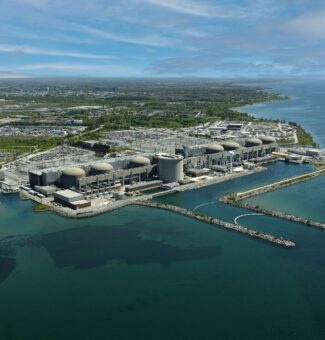Nuclear products and their unseen wonders
Whether it be sterilizing medical equipment and food or providing luminescent lighting on airplanes and wrist watches, Ontario’s nuclear products help keep us healthy and safe in a myriad of ways.
For decades, OPG has been supplying the world with valuable radioactive isotopes harvested from its nuclear reactors at Pickering Nuclear Generating Station (GS) and Darlington Nuclear GS. These isotopes, which include heavy water, Cobalt-60, and tritium, are key components in applications in medicine, sterilization, food preservation, lighting, and fusion research.
And the future for further innovation in this area is looking brighter than ever.
We’re affecting health care in a positive way and producing hundreds of jobs in the process. In the case of tritium, we’re turning what could be waste into an asset. Isotope sales are a strong financial contributor to OPG’s bottom line.David Zekveld, Senior Manager of Isotopes Sales for OPG

Forty per cent of the world’s single-use medical devices, such as syringes, gloves, implants and surgical instruments, are irradiated and sterilized with Cobalt-60. The isotope emits gamma radiation, which makes it ideal to enhance the safety of medical products and perishable foods such as fruits, meats and spices.
Currently, Cobalt-60 is extracted from reactors at Pickering Nuclear every 24 months as well as at Bruce Power’s Bruce B plant. Plans are underway to expand Cobalt-60 production to Darlington Nuclear to ensure its steady supply as operations at Pickering wind down in 2024. Ontario’s CANDU reactors produce 50 per cent of the world’s supply of the isotope.
“We’re creating a great number of jobs simply by harvesting Cobalt-60,” Zekveld said.
OPG also produces and sells heavy water, or deuterium, an isotope used as a moderator in CANDU reactors to sustain a chain reaction. Virgin deuterium (which has not been used in a reactor) can be used to enhance magnetic resonance imaging and help pharmaceuticals last longer in the bloodstream.
Another radioactive isotope, tritium, is also commercially available from OPG. A by-product of the daily operations of a CANDU nuclear reactor, tritium is handled as a hazard at nuclear sites, but it is also used in the production of self-powered lights and medical research.
Minute amounts of tritium combined with phosphor create luminescence – a long-lasting, self-powered light source that does not require electricity. Tritium helps light up watch dials, keychains and military equipment, as well as land-mine markers and emergency exit signs in commercial buildings and airplanes.
Looking to the future, OPG is investigating the production of new isotopes, like Helium-3 and Plutonium-238. Helium-3 is used in lung imaging, detecting nuclear bombs, and could act as a fuel source in future nuclear fusion plants, while Plutonium-238 is used to power spacecraft involved in deep space exploration.
Helium-3 is extremely rare and a potential fusion power source. There is talk about mining the moon for Helium-3, but we don’t have to go to the moon. We have a sufficient supply right here and we plan to come to market for that very soon.David Zekveld, Senior Manager of Isotopes Sales for OPG
OPG is currently investigating the viability of producing Plutonium-238 at Darlington Nuclear’s reactors. The isotope, which can’t be used to make nuclear weapons, emits steady heat due to its natural radioactive decay and can act as a heat source and battery to power deep space probes.
Subscribe and stay informed
Sign up to receive the latest news, project updates, and event information from OPG.


